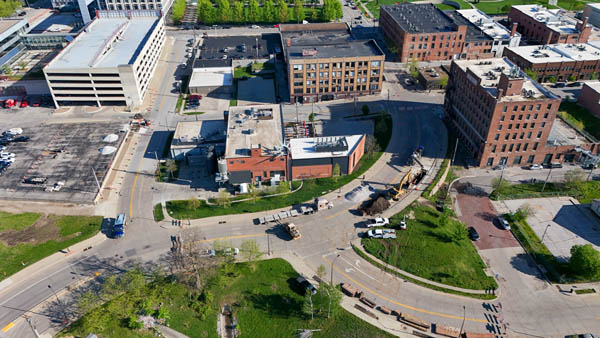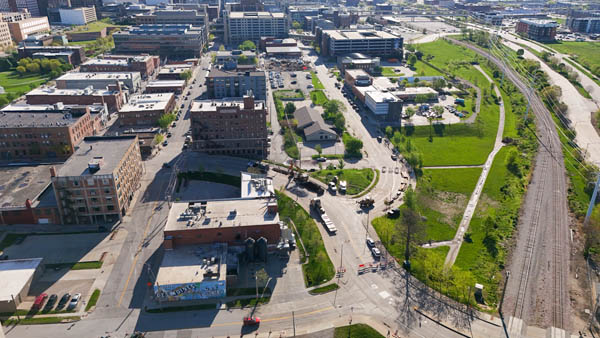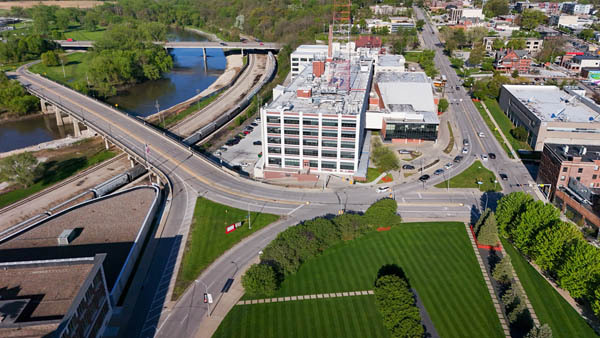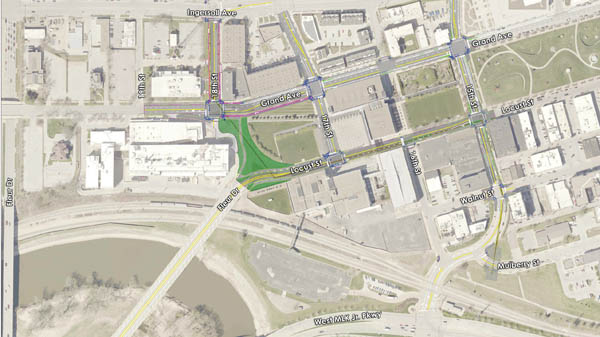WRA and the City of Des Moines Partnership a Boon for Growth and Development
This article includes interviews from the following Des Moines Parks & Rec employees:
Few people wonder what happens to the water they use to cook, clean and drink after it gets flushed or poured down the drain, but it plays a huge role in their lives well beyond that initial use. It may be called “wastewater,” but everything that enters our sanitary sewer system eventually makes its way to the WRA’s treatment facility. This is where your used water gets recycled, producing useful biogas and biosolids that can be applied to farms and, most importantly, high-quality reclaimed wastewater that is discharged back into the Des Moines River, where it can once again be used to provide clean water to Greater Des Moines (DSM).
The WRA treats over 60 million gallons of wastewater every day, equivalent to roughly 450 million water bottles. While it’s an impressive volume of water, there are limits to how much the facility can effectively treat, particularly during periods of heavy rainfall. This is due to the prevalence of combined sewer systems (CSS). In basic terms, a CSS is a sewer where both stormwater and wastewater flow to the treatment facility through the same system. In the past there were several CSS overflows within the sewer system, that during heavy rainfall events, would discharge all the overflow (sanitary and storm) directly to a local river. The Environmental Protection Agency (EPA) has mandated the removal of these CSS overflows to reduce the occurrence of untreated wastewater being discharged into the river. The WRA is currently equipped with a Wet Weather Facility to handle these overflows to provide further treatment prior to discharging the flow to the river. The construction of a new, large diameter sanitary sewer pipe to convey this CSS overflow to the treatment plant is needed to comply with the EPA and eliminate the CSS overflow. Common in many Midwest cities such as Milwaukee, Chicago and Kansas City, Des Moines is ready to replace these overflowing systems with modern infrastructure built to serve our community and the region for decades to come.
About the WRA’s Ingersoll Run Outlet Sewer Project
Enter the WRA’s Ingersoll Run Outlet Sewer Project. Split into three segments, work began in 2022 on Segment 3 near 22nd and High Street to install a brand-new sanitary sewer that would eliminate the combined sewer overflow west of Martin Luther King Jr. Parkway by diverting wastewater to the WRA’s treatment facilities.

Though the name of the project may lead one to believe Ingersoll Avenue to be the main staging area, the most disruptive of these segments was Segment 1, spanning the majority of West Martin Luther King Jr. Parkway, from SW 16th Street to SW 2nd Street, which required the complete closure of the northern lanes to install five-foot diameter sewer 15 to 20 feet deep beneath the ground.

With work on Segment 1 set to wrap up by Monday, July 1 — several months ahead of the original December 2024 estimated completion date — residents and visitors to Downtown Des Moines (DSM) will once again have full access to a major arterial roadway as summer event season kicks off.
The WRA has already started work on the final portion of the Ingersoll Run Project, Segment 2, primarily in the vicinity of Downtown DSM’s Western Gateway Park. This final sewer installation will connect all segments of the project to create a brand-new conveyance system designed to eliminate one of the last remaining CSS overflows in Des Moines.

Segment 2 begins at 15th and Mulberry Streets near the Segment 1 connection and continues north to Locust Street, then northwest, passing the Fleur Drive Bridge towards 18th Street between Grand and Ingersoll Avenues where it will connect to Segment 3. Work on Segment 2 is currently slated to continue through December 2025.

City of Des Moines Traffic Improvements
With several streets being dug up to install the new sewer lines, the WRA is working with the City of Des Moines’ Engineering Department to complete several traffic improvements. The decision to complete both projects simultaneously was made to reduce the impact on residents and travelers downtown.
The unique intersection of several major streets between Central Campus, Dotdash Meredith and MidAmerican Energy once saw 36,000 travelers per day as a major access point between Downtown DSM and the region’s southside, including the Des Moines International Airport. Once West Martin Luther King Jr. Parkway was completed in the early 2000’s, Fleur Drive bridge numbers declined to about 6,000 per day. Looking for an opportunity that was efficient and made sense, the City Engineering staff determined that now is the perfect time to improve the traffic flow around this obscure intersection.
Starting Monday, June 3, the intersection of Fleur Drive, Locust Street, Grand Avenue and 18th Street will permanently close as work begins to replace the area with green space that will host a new, multi-use trail, connecting Ingersoll Avenue to the Meredith trail. These changes add back desired greenspace, opening future opportunities for public use.
Other traffic flow and safety improvements include curb bump-outs for safer pedestrian crosswalks and alterations to Locust Street and Grand Avenue that could see the addition of raised barriers, painted bike lanes and one-way to two-way traffic conversions west of 15th Street. The Engineering Department also plans on reconstructing the Fleur Drive bridge to complement the new traffic-calming changes in a separate project in the next few years.
While disruptions to vehicular traffic are never ideal, residents can take solace in the fact that this essential work will benefit our waterways and protect the health of Des Moines’ ecosystems. Visitors to downtown will also celebrate a more pedestrian-friendly entrance to the City’s hub for restaurants and events, with safer streets for all travelers.
The partnership between the WRA and the City of Des Moines is a boon to the growth and development of a safe, healthy and enjoyable environment in DSM. That partnership is bolstered by the support and patience of Des Moines residents as well as local businesses, commuters and visitors to our energetic downtown district. These improvements and essential upgrades are planned and executed with the primary objective of improving the quality of life in DSM, and we express our deepest thanks to those served by this important work as we strive to achieve that goal.
Watch the video below to learn more:
Author Profiles
|
Des Moines Public Works
DMMWRA, IA | Official Website
mdschlickbernd@dmgov.org
Melissa Schlickbernd is a Facilities Engineer for the Des Moines Metropolitan Wastewater Reclamation Authority (WRA). The WRA is made-up of 18 metro area municipalities, counties and sewer districts. They work together to protect public health and to enhance the environment by recycling wastewater and being the preferred treatment facilities for hauled liquid waste.
|
|
City of Des Moines Engineering
DSM.city/Projects
slnaber@dmgov.org
Steven Naber is the City Engineer for the City of Des Moines. The Engineering Department oversees the construction of public infrastructure and maintenance of traffic control systems essential to Des Moines residents, businesses, and guests. The Engineering Department’s work aims to improve safety, health, mobility and quality of life in Des Moines.
|
Greater Des Moines (DSM) has one of the best business climates in the country. The region is nationally recognized for having a talented and educated workforce, a cost of doing business 13% below the national average, a low cost of living and an exceptional quality of life. In 2022, Site Selection Magazine named it a top metro for a number of economic development projects.